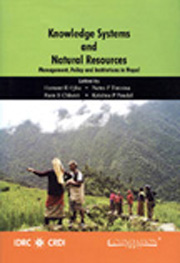Book contents
- Frontmatter
- Contents
- Preface
- Abbreviations
- Glossary of Nepali Words
- 1 Knowledge Systems and Deliberative Interface in Natural Resource Governance: An Overiew
- 2 Agricultural Technology Development in Nepal: Critical Assessment from Knowledge System Perspective
- 3 Contested Knowledge and Reconciliation in Nepal's Community Forestry: A Case of Forest Inventory Policy
- 4 From Grassroots to Policy Deliberation: The Case of Community Forest Users' Federation in Nepal
- 5 From Isolation to Interaction: Increasing Knowledge Interface in Chhattis Mauja Irrigation system in Nepal
- 6 Action Research Experience on Democratising Knowledge in Community Forestry in Nepal
- 7 Culturally Embedded Knowledge in Irrigation: People's Ways of Thriving in a Himalayan Village
- 8 Deliberative Knowledge Interface: Lessons and Policy Implications
- About the Contributors
2 - Agricultural Technology Development in Nepal: Critical Assessment from Knowledge System Perspective
Published online by Cambridge University Press: 26 October 2011
- Frontmatter
- Contents
- Preface
- Abbreviations
- Glossary of Nepali Words
- 1 Knowledge Systems and Deliberative Interface in Natural Resource Governance: An Overiew
- 2 Agricultural Technology Development in Nepal: Critical Assessment from Knowledge System Perspective
- 3 Contested Knowledge and Reconciliation in Nepal's Community Forestry: A Case of Forest Inventory Policy
- 4 From Grassroots to Policy Deliberation: The Case of Community Forest Users' Federation in Nepal
- 5 From Isolation to Interaction: Increasing Knowledge Interface in Chhattis Mauja Irrigation system in Nepal
- 6 Action Research Experience on Democratising Knowledge in Community Forestry in Nepal
- 7 Culturally Embedded Knowledge in Irrigation: People's Ways of Thriving in a Himalayan Village
- 8 Deliberative Knowledge Interface: Lessons and Policy Implications
- About the Contributors
Summary
Introduction
Agriculture has been the foundation of Nepalese economy and has been part of the culture, knowledge system and way of life of Nepali society for centuries. Today approximately 80 per cent of the population depends on agriculture for subsistence. Realising the importance of agriculture as a means of livelihood, for majority of the people, the government began planned interventions in the agriculture sector in the 1950s. Technological inputs particularly the introduction of improved varieties of crops and their trials were the initial outside interventions in agriculture. The focus on the production of crops under the influence of dominant discourse of science and technology has created an inherent conflict between the scientific and indigenous knowledge systems.
The government of Nepal developed the Agriculture Perspective Plan (APP) in 1995. The objectives of APP were to reduce the proportion of population living below the poverty line and to specifically include rural poor women in that process through agricultural interventions. It was an action plan, which identified four key priority areas of input and output. Priority inputs included irrigation, fertiliser, technology, roads and power, whereas priority outputs included livestock, high value crops, agribusiness and forestry (APP 1995; JMA and APROSC 1998). In line with the APP, the sole objective of the Tenth Plan (2002–2007) of Nepal was set ‘to bring about a remarkable and sustainable reduction in the poverty level’. The Tenth Plan focused on two major areas for the agriculture sector:
a. to increase agricultural production, productivity, and income for food security and poverty reduction
b. develop local and export market opportunities (NPC 2002).
- Type
- Chapter
- Information
- Knowledge Systems and Natural ResourcesManagement, Policy, and Institutions in Nepal, pp. 23 - 39Publisher: Foundation BooksPrint publication year: 2007



